How does urban gardening lead communities to question urban soil quality?
URBiNAT scientific partners from Nantes recently published an article in the Journal Projets de Paysage.
Le sol, enveloppe superficielle de la Terre, est formé par l’altération des roches-mères et d’apports exogènes. Il est composé de matière organique et minérale, d’eau, d’air et d’organismes vivants intimement liés. En milieu urbain, les sols, fortement influencés
par les activités humaines passées et présentes, se caractérisent par une forte hétérogénéité horizontale et verticale (Béchet et al., 2009). Support indispensable des activités humaines et des écosystèmes terrestres, le sol est paradoxalement le compartiment de l’environnement biophysique urbain le moins abordé. Juliette Fournil, Juliette Kon Kam King, Céline Granjou et Lauric Cécillon (2018) parlent de « l’invisibilité du sol ». Pour les non-experts, il fait souvent l’objet de représentations erronées ou tronquées. Il est alors perçu comme un matériau inerte et associé à une surface sans considération de son épaisseur. Le scellement des sols par différents revêtements contribue à son invisibilisation. Le fait est que le sol reste encore souvent abordé sous l’angle restrictif de la propriété foncière (Desrousseaux, 2021) et non comme un « bien commun » limite une approche globale de l’environnement.


Soil, the Earth’s surface envelope, is formed by the alteration of parent rocks and exogenous inputs. It is composed of organic and mineral matter, water, air and and living organisms that are intricately linked. In an urban environment, soils are strongly influenced by past and present human activities, are characterised by strong horizontal and vertical heterogeneity (Béchet et al., 2009). As an essential supporting mechanism for human activities and terrestrial ecosystems, soil is paradoxically the least studied component of the urban biophysical environment. Juliette Fournil, Juliette Kon Kam King, Céline Granjou and Lauric Cécillon (2018) speak of the ‘invisibility of soil’. For non-experts, it is often the subject of erroneous or truncated representations. It is perceived as an inert material and associated with a surface without consideration for its thickness. The covering of floors with different materials contributes to its invisibility. The fact is that soil is still often approached from the restrictive perspective of land ownership (Desrousseaux, 2021) and not as a ‘common good’, which limits a global approach to the environment.







